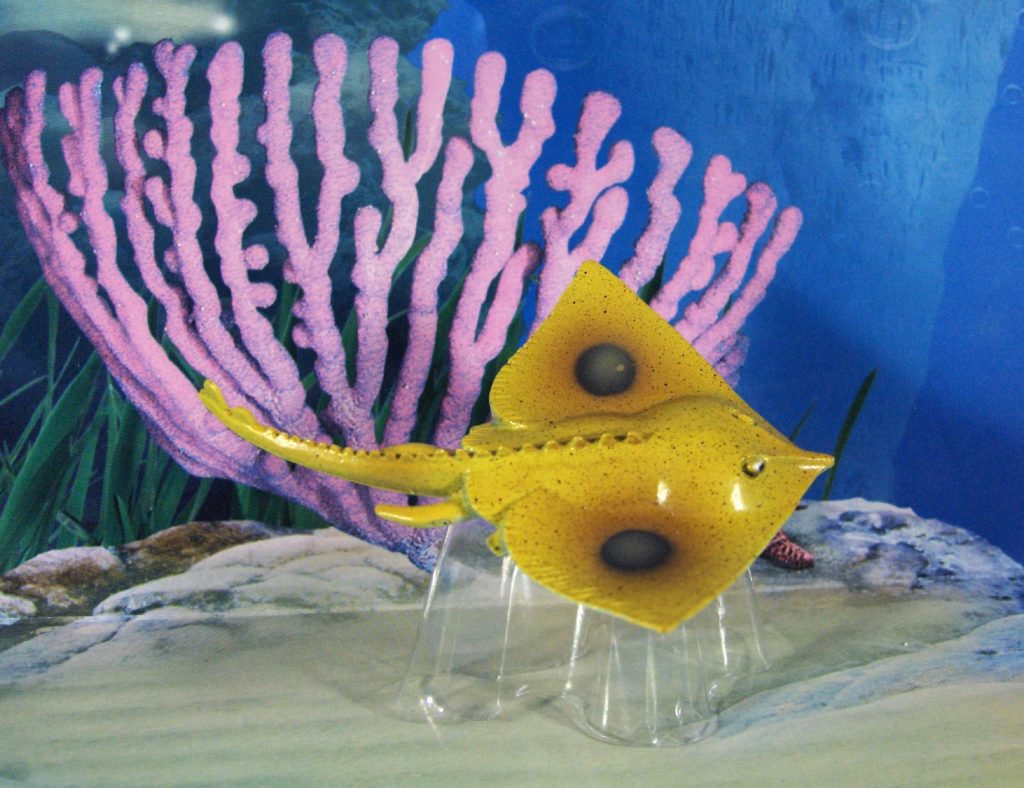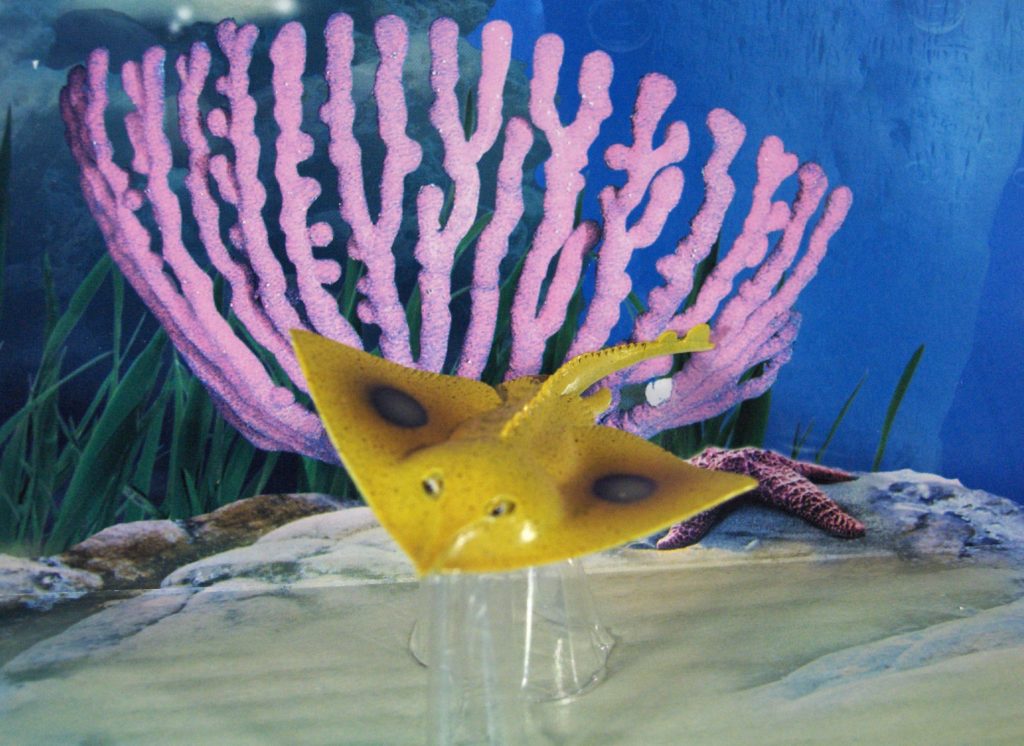This post will be discussing an unusual figure from an unusual line–the line is the figures made by Bandai in conjunction with the game Animal Kaiser, and the animal is a Velez’ ray or Velez skate, Rostroraja velezi (Chirichigno, 1973). First off, ray or skate? Well, even Fishbase refers to it as a ‘ray’, but the genus Raja refers to the skates, which are a type of ray. So my personal preference is to call it a skate to differentiate it from other rays like eagle rays, manta rays, stingrays, torpedo rays, etc.

Where did this figure come from? Well, Bandai is fairly well known as a figure company, and they get involved with a variety of lines for various purposes. Some are capsule figures, some are products sold on shelves in stores, and some like this Velez skate are created as blind bag toys. In this case, the line was Animal Kaiser, a game that, I think, is both a video game and a card game, and somehow includes animals that fight each other. The figures come with a card that describes the animal and, more importantly, names them to species! So even if the species of this figure was not obvious (it is, as we’ll see), the card clearly states Raja velezi. This is true of all of their realistic figures–but of course, as the series of figures continues, there are all kinds of variants and fantastic things like a UFO and mech versions (yes…I have some of those too…). I don’t think the line is still active, having ended with some prehistoric animals several years back, but they are still available on Japanese auction and resale sites (maybe…I haven’t looked in a while).

So what is this fish? Well, it’s one of many species of skate, family Rajidae, in the order Rajiformes, one of the orders of Batoidea, a group that includes all of the ‘flat sharks’ (stingrays and kin, guitarfishes, skates, and torpedo rays). Like all sharks and rays, they have cartilaginous skeletons. Skates have the familiar flat body like other rays, with pectoral fins forming a continuous line with the body in the form of ‘wings’, giving an asymmetrical diamond shape. The gills and nostrils are on the underside of the head, while on the top are the eyes and spiracles (breathing openings). Skates in particular have at least somewhat extended rostrum on a fixed snout. They often also have thicker tails with distinct dorsal fins toward the end of the tail. Of course, there is variability in the skates.

The Velez skate itself could be described as a typical skate, featuring all of the expected features and no extreme morphologies. The species is found along the coast of the eastern Pacific Ocean, from the Gulf of California in the north to Peru and Ecuador (including the Galapagos islands) in the south. This distribution makes its inclusion in a Japanese game unusual (there are several species of Rajiformes near Japan). But whatever, unusual choice=unusual animal figure so I’ll take it! Like most skates, Velez skates tend to be offshore, deeper water animals with benthic lifestyles. They are carnivorous, feeding on fish and invertebrates on the continental shelf. Although many rays are live-bearing (viviparous or ovoviviparous) Velez skates lay produce young in egg cases called mermaids’ purses. They are listed as Data Deficient and we can hope that their populations are at least stable.

So the figure–how is this figure? First, the size–the figure is 7.5cm long; the average length of the male Velez skate is 83cm long, giving a scale of 1:11. Overall, the sculpt is EXCELLENT. Yes, caps lock Excellent. For a merch-tie-in figure, they seriously did all of their homework. The basic details are definitely there–the eyes set right at the anterior margin of the spiracles, the single median thorn row of raised denticles (maybe a little over-emphasized), the pointed rostrum, the thickened body, with distinct margins indicating the pectoral wings, the small dorsal fins on the tail. This figure has done a great job of capturing what a rajid skate should look like. But in the details, they also made sure that this is obviously a Velez skate. The distinctive pelvic fins would have been an easy one to miss–these rear paired fins have a bit of a…split?—giving the appearance of a smaller lobe in front of a larger lobe. On a lesser sculpt, this would have likely been ignored (or worse, treated as 2 separate fins) but they actually produced it with the fin shape correctly. And then, adding to their work, they added claspers under the pelvic fins to make it obviously a male. These sculpt choices, plus other little elements like correctly detailing the gill slits, mouth, nostrils and even the ridge in front of the eyes, add to an expert sculpt. Again, for a simple blind bag toy. For a card game.

As for the painting…they weren’t lazy there either, at least on the dorsal surface. The body is a base yellow ochre (most images look more brownish) with a darker brown wash across the middle of the back, from wingtip to wingtip. The characteristic bullseye spots are included on the pectorals, which are a little large and could have used a second dark ring on the inside–again, we know it’s a Velez skate from this. And then the whole dorsal surface has a light speckling of tiny black spots, giving it a more life-like appearance. Sadly, the ventral surface is left as plain white, instead of brown along the snout, wingtips and tail. The whole figure is then finished in a shiny gloss.
To conclude, this Velez skate is a good example of Animal Kaiser figures at their best. It has a detailed sculpt and pretty accurate paint job, identified to species. They are not all like this (if you want to see a more medium-place figure, I discussed their Sperm Whale on my personal blog). As with all lines, there is quite a bit of variety in quality–but unlike some lines, there is also a wide variety in species (different times, clades, quality, etc)! I have many others, and will try to go over more here in the future (that said, I’ll never get the hyena, sadly…it’s only available as one of their anthropomorphic figures. Blech). As for your own collections, look them up. They were discussed many years ago on the Animal Toy Forum and information can likely be found around the internet of course. But once you know which ones you need (the Luchador maybe? yeah, it’s a weird series) you’ll probably need to check out Japanese sources, as I said earlier. Good luck!
Disclaimer: links to Ebay and Amazon on the AnimalToyBlog are affiliate links, so we make a small commission if you use them. Thanks for supporting us!




Animal kaiser is hilarious. The arcade game has the gall to say “the animals in this game exist in real life!” while showing purple lions, ninja wolves and robot sharks 😀
I used to play the game until they rebooted into “Great Animal Kaiser” that rendered my card collection useless, and the game was discontinued in my country after that.